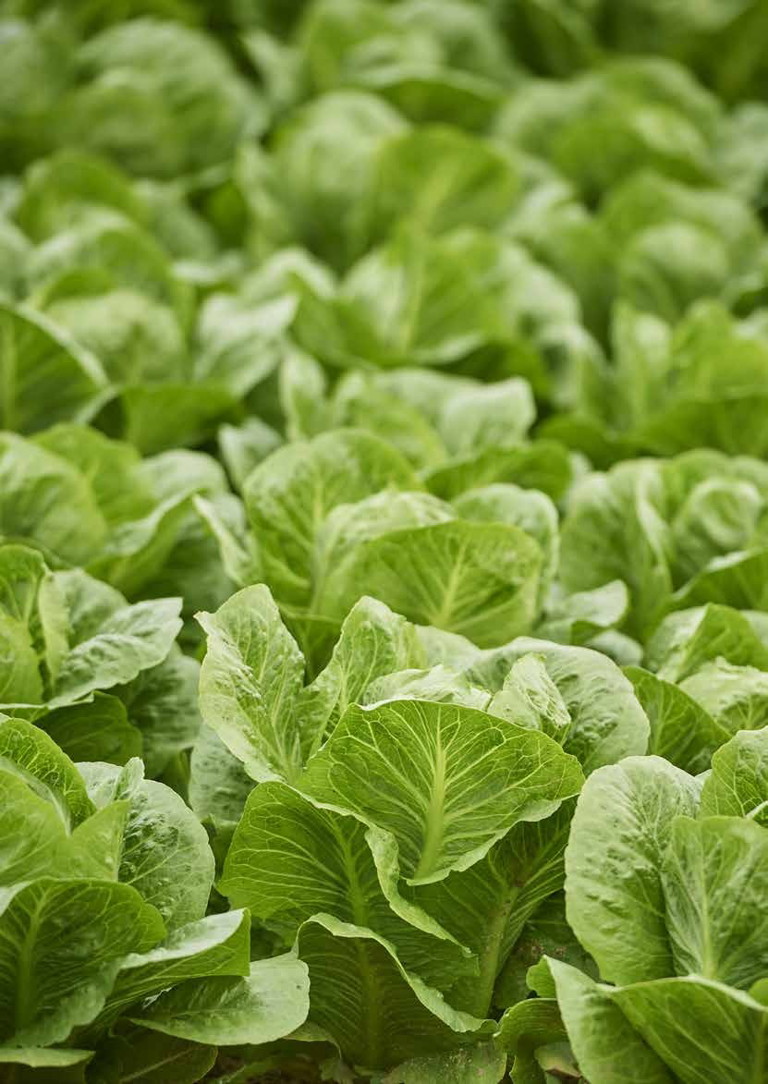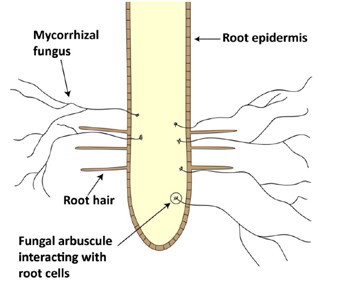sustainability
Dishing THE DIRT
What’s the secret to optimum soil biology? vegetablesWA RDO Chi Nguyen says it’s all about mycorrhizal fungi if you want thriving vegetables.

Photography
Frances Andrijich

IN the world of vegetable growing, poor crop quality and escalating pest challenges are not mere accidents or strokes of bad luck. Our approach to agriculture often involves treating symptoms rather than addressing the root cause of a problem. The hidden heroes of farming success are soil micro-organisms. However, in modern agriculture, these micro-organisms face numerous challenges. There is hope for their survival and it’s all about microbe management, these are the strategies to consider :
Microbe-Friendly Practices Adopt practices that are friendly to microbes, such as reduced tillage and minimising the use of salts and chemicals.
Microbial Inoculation Introduce new microbes into the soil using compost and microbial inoculums to enhance microbial diversity.
Cocktail Cover Crops Foster soil life by planting cover crops and allowing stubble digestion.
Humates for Optimal Conditions Create optimum microbial growth with humates, stimulating the soil’s microbial population.
Foliar Fertilisation Accelerate chlorophyll production through foliar fertilisation, promoting the generation of exudates.
Chemical Elimination Reduce or eliminate the use of harmful chemicals detrimental to soil micro-organisms.
Earthworm Revival Bring back earthworms, which are essential contributors to soil health.
“ Recognising the natural nematicidal properties of mycorrhizal fungi provides an environmentally friendly alternative to chemical options ”

The Mycorrhizal Marvel
A crucial player in soil biology is mycorrhizal fungi. This fungi is made up of arbuscular mycorrhizal fungi (AMF) and ectomycorrhizal fungi (EF). AMF establishes symbiotic connections with the roots of almost all soil-grown plants, fostering enhanced growth and productivity through improved nutrient acquisition, including phosphorus, water and minerals. AMF also contributes significantly to plant tolerance and resilience against abiotic stressors, such as drought, salt and heavy metal toxicity.
The arbuscular mycorrhizal interface facilitates the exchange of nutrients, plus signals molecules and protective chemical compounds between fungal and plant partners. AMF infestation influences plants’ antioxidant defense systems, osmotic adjustment and hormone regulation. This impacts plant performance, photosynthetic efficiency and biomass production under abiotic stress conditions.
AMF also plays a crucial role in enhancing soil structure, nutrient cycling and carbon sequestration. This contributes to the maintenance of resilient ecosystems. Note: species and environmental factors impact its effects on growth and ecological stability.
AMF’s growth-regulating and productivity-enhancing role in alleviating abiotic stress underscores its impact on plants’ morphological, physiological and molecular responses to stressors. The symbiosis with AMF not only improves water and nutrient acquisition, but also modulates antioxidant defense mechanisms, osmotic adjustment and hormonal regulation in plants. These orchestrated responses culminate in heightened plant performance, increased photosynthetic efficiency and enhanced biomass production when confronted with abiotic stress.
What has Killed Off 90% of our Mycorrhizal Fungi?
The delicate and essential mycorrhizal network, which is crucial for soil health, has faced a massive decline in conventional agriculture, succumbing to various human-induced factors. Excessive tillage stands as a primary culprit, disrupting the intricate mycorrhizal web, highlighting the need for a transition to minimum tillage practices to ensure better preservation. The use of unbuffered, high salt index fertilisers also poses a significant threat by dehydrating mycorrhizal mycelium, exacerbating the network’s vulnerability. Unbuffered monoammonium phosphate and di-ammonium phosphate fertilisers have been identified as contributors to the decline, emphasising the importance of careful and considerate fertiliser selection. Chemical nematicides further compound the issue, proving to be particularly toxic to mycorrhizal fungi and exacerbating the decline of this essential network.
Reclaiming Our Mycorrhizal Networks
To reclaim and rejuvenate our mycorrhizal networks, a multifaceted approach is crucial. For vegetable crops, treating seedlings ensures that mycorrhizal colonisation begins from day one to foster a resilient and robust network. Pasture cropping, involving the treatment of introduced seeds, is a pivotal strategy for pasture re-colonisation.
Recognising the natural nematicidal properties of mycorrhizal fungi provides an environmentally friendly alternative to chemical options. Harnessing this quality can significantly reduce the damage associated with traditional nematicides while aiding in the restoration of the mycorrhizal network.
The strategic combination of cover crops, such as oats and crimson clover, proves beneficial in stimulating mycorrhizal fungi. These cover crops not only provide valuable organic matter to the soil, but also create an environment conducive to mycorrhizal proliferation, fostering a relationship that supports plant health and soil vitality.
Understanding and harnessing the power of mycorrhizal fungi can pave the way for sustainable and thriving vegetable crops. By addressing the root causes of crop challenges and embracing microbial management, vegetable growers can embark on a more sustainable agricultural future.
What You Need to Know: Microbial Inoculants & Aerobic Teas
Microbial inoculants come in various types, including broadspectrum inoculums with maximum biodiversity (such as compost and compost teas), task-specific blends and singlespecies inoculums. When it comes to aerobic tea brewing, achieving a consistent microbe brew depends on several critical aspects. Understanding the dynamics and requirements of aerobic microbes is fundamental to this process, involving the creation of an optimal environment for reproduction.
Temperature plays a key role in the brewing process; metabolic rates double with every 10°C increase. Ideal temperatures vary for different components of the brew, such as bacteria (25-35°C), fungaldominated brew (15-25°C) and protozoa-dominated brew (25-30°C). Deviations from ideal temperatures may require extending the brewing time.
Microbe food diversity is essential, with higher species variety and numbers demanding a varied food source. The food source should make up no more than one per cent of the brewed volume. Examples of suitable food sources include amino acids, aloe vera (fungal), micronised minerals, humic acid (fungal), fulvic acid, kelp (fungal), fish hydrolysate (fungal), fish emulsion (bacteria) and molasses (bacteria).
Ensuring a high-quality microbial inoculant involves considerations such as high colony-forming units, specified biodiversity and other relevant factors. Oxygen concentration, measured as dissolved oxygen (DO) is crucial. The ideal DO is 8 mg/L, with a minimum of 6 mg/L at peak. A DO level below 6 mg/L can compromise the microbial community.
Water quality is also significant, with recommended pH levels for bacteria (7–7.4) and fungi (below 6). The electrical conductivity should be below 700 uS/cm, and the water should be noncontaminated and chloride-free. In terms of hardware, a suitable setup should be easy to clean, ensure an even distribution of DO and include the correct pump and hoses.

On-farm Microbe Monitoring
A new technology – the Microbiometer – measures soil life potential in real-time. This on-farm test kit works via a phone app. It measures a soil’s total microbial biomass and fungi-to-bacteria ratio. According to Prolific Earth Sciences, the United States-based maker of the product, “the higher the microbial biomass, the more nutriuents are available to plants naturally”. How does the kit work? President Dr Judith Fitzpatrick explains an extraction powder loosens microbes from a soil sample, then it’s whisked and placed on a card. The card’s membrane captures coloured microbes and the app analyses it via the phone. The amount of colour correlates with the amount of microbes. Microbial biomass is expressed as a biomass of carbon (assuming dry weight of microbes is 50 per cent carbon). The Australian agent is David von Plein on 07 4635 7065 or read more about at microbiometer.com.
“ AMF also plays a role in enhancing soil structure, nutrient cycling and carbon sequestration. This contributes to ... resilient ecosystems ”
Nutrition Farming Webinar
Want to learn more about soil biology, reclaiming mycorrhizal fungi and microbial brewing and management? Watch our recorded Nutrition Farming Webinar – The Soil Foodweb: Microbe Management – which was a collaboration between vegetablesWA and Nutri-Tech Solutions. Visit the Webinar at bit.ly/3GSzLXi.